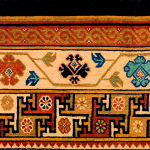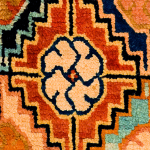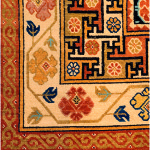Anatomy of an Object: Chinese Carpet, Late Ming Period

Chinese geometric carpet with stepped diamonds and rosettes, probably Imperial Palace workshop, Beijing, late Ming period, early 17th century. Wool pile on a cotton foundation, 3.10 x 4.70 m (10′ 2″ x 15′ 5″). Palace Museum, Beijing, no.21196
A structural uniformity is disguised by apparent randomness caused by the extensive colour range used in the field of this classical carpet in the Beijing Palace Museum.
Numerous sophisticated geometric designs appear on classical Chinese carpets. Many have a lattice or grid composition, sometimes creating the illusion of multiple layers. The lattice on this magnificent dais or daybed cover, which retains most of its original colours, is composed of a lower layer of interlocking stepped diamonds with rosettes at their centres, forming offset rows of compartments which alternate in ground colour. In the four corners of each of the squares are quartered sections of stepped diamonds, so the diamond form repeats in squares, vertically, horizontally and diagonally. The rosette motif is fluid, and its interior is constructed to create the illusion of rotation.
Read more about classical Chinese wool pile carpets in ‘Anatomy of an object’ in HALI 195.

Anatomy of an object
4 images
Learn more about the design elements of this Chinese carpet from late Ming period
- A complex black swastika fret pattern containing small rosettes forms the main border. It is backed by an alternating tan, ivory and red-brown ground, which imparts a lively sense of rotation.
- Much of the beauty of the design lies in its apparent randomness and the extensive colour range used for the diamonds.
- Fluid rosettes suggestive of rotation are often seen in Beijing carpets, but rarely in those from Ningxia, suggesting that this probably came from the imperial workshops.
- The meandering stem of the secondary border is resolved at the corners meaning that evenly spaced peonies can bloom uninterrupted around the whole field. Thin gold borders outlined in black create a clear separation.






























Comments [0] Sign in to comment